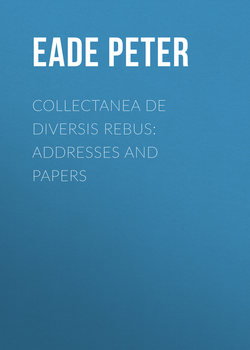Читать книгу Collectanea de Diversis Rebus: Addresses and Papers - Eade Peter - Страница 5
IV.
A FURTHER NOTE UPON TORTOISES. 5
ОглавлениеIn the year 1886 I read before this Society a paper in which I recorded some of the observed habits and peculiarities of a pair of Tortoises which I had then kept in my garden for three and four years respectively. This paper was afterwards published in our Society’s “Transactions” (Vol. iv. p. 316), and will probably be remembered by some of our members.
I would like this evening to say a few further words upon these creatures, which are still living and in my possession – more particularly with reference to their rate of growth and increase.
The two Tortoises have now been in my possession ten and nine years respectively. Six years ago I reported to this Society that they measured, the one 7½ and the other 7 inches in length. Now at the end of six further years their antero-posterior measurements are 9½ and 9 inches respectively – the measurements being made from before backwards over the convex surface of the carapace. They have, therefore, each of them, thus measured, increased exactly two inches in length in the last six years, or at the rate of exactly one-third of an inch per year.
(The under flat surface of the shell now measures 6½ and 6¼ inches from before backwards. These Tortoises are said not usually to exceed 10 inches in entire length.)
Then as to their weight. I have now kept an exact record of their respective weights in the spring and autumn of each of the past seven years, i. e. their weight on commencing to hybernate in October or November, and again their weight on returning afresh to light and more active existence in April or May of the following spring. And it is interesting to notice how almost continuously they have increased both in size and weight; and also how corresponding are the alterations, or otherwise, in the consecutive years, both of spring and autumn, of the two animals.
In my former paper, I mentioned that during the summer months of 1886, when I first weighed them, i. e. from May to September, my Tortoises had gained in weight, the one 2½ ounces, and the other 1½ ounces; whilst each of them became lighter in the following winter by 2½ ounces. Since that time the spring and autumn weighings have been regularly continued, and the result is shown in the following table.
In the seven years, therefore, 1886 to 1892, the larger Tortoise has increased in weight from 2 lbs. 10 ozs. to 3 lbs. 3½ ozs.; and the smaller Tortoise from 2 lbs. 5 ozs. to 2 lbs. 14½ ozs., giving a total increase of weight in this period of exactly 9 ounces for each animal, or an average annual increase of about 1 ounce and 5½ drachms (avoirdupois).
The general result also of the above weighings is to show that, in average seasons in England, these creatures gain from 2 to 2½ ounces in each summer, and lose again a varying but considerable portion of this increase during the ensuing six or seven months of hybernation; but, on the whole, showing an average gain of a little more than one ounce in the year – the average gain of weight per month in summer working out at about 6 or 7 drachms, with an average loss in the winter months of about 4 or 5 drachms per month. This last fact scarcely agrees with Cuvier’s statement that “during winter.. their loss of substance amounts almost to nothing.”
It will be noted that the foregoing table shows certain variations in the increases and decreases of weight in the several years; also that in two of the years there was but little change between the autumn and spring weights – this period of stagnation occurring in both animals simultaneously. Probably several causes for this were at work, but I have little doubt that the variability of our English seasons is by far the largest factor in the case; and that the variations in the gainings and losings of the different summers and winters depend very largely upon the special character of these seasons. Thus, when the summer months are hot the Tortoises eat much more abundantly and constantly, and consequently put on (or rather put inside their skeletons) much more flesh than in colder seasons. On the contrary, a warm autumn, with the temperature not sufficiently cold to make them go early and thoroughly to sleep, must conduce to greater loss, or rather waste, of their flesh, for it is well known that these animals cease to eat many weeks before they finally retire to rest for the winter; and necessarily during this period, especially on sunny days in which (even at this season) they are often moderately lively and active, they are doubtless breathing and consuming some of the material which has been stored up for winter consumption. Whilst again, in a very mild winter or spring they will, as is well known, frequently wake up from their dormancy, and of course, on each such occasion will make further inroads upon their reservoir of nutrient material.
It is therefore pretty certain that hot summers and cold winters are most conducive to their rapid increase in size and weight; whilst of course the contrary conditions would have an exactly opposite result.
